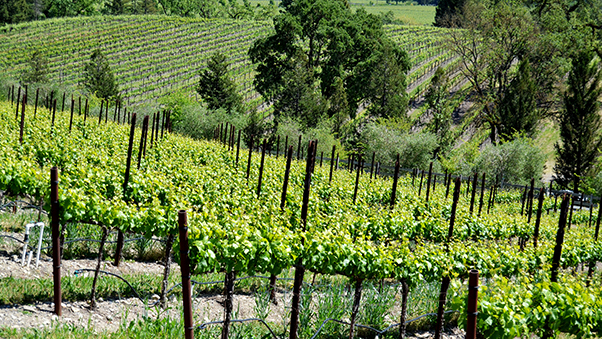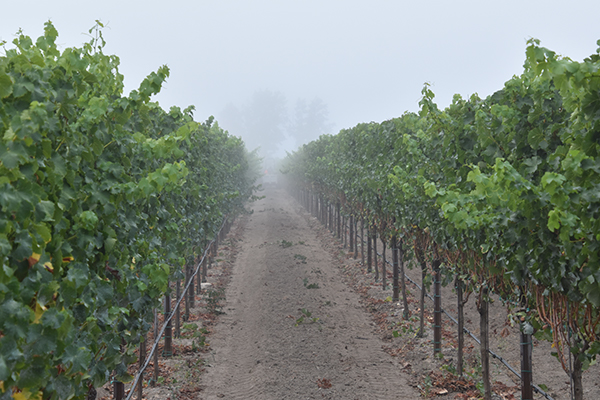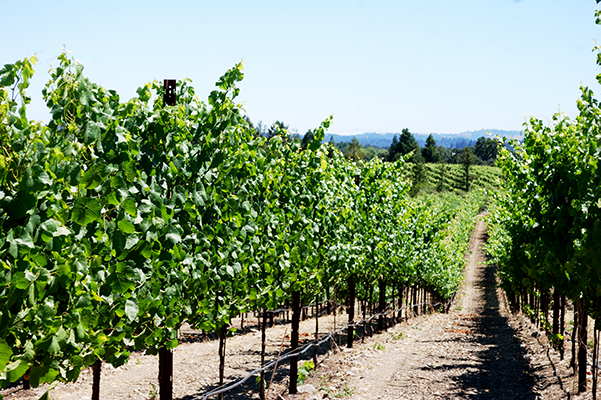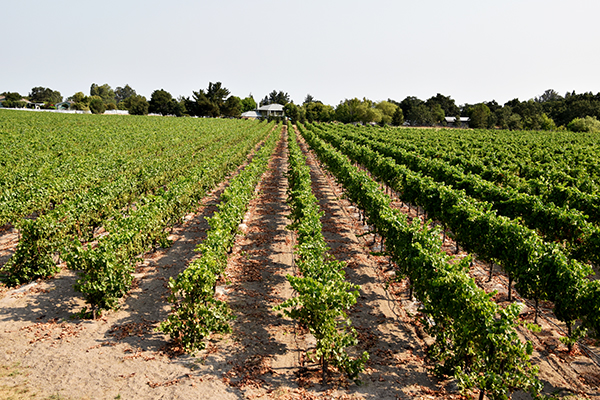
Our search for the ideal location to grow world class Pinot noir led us directly to the Russian River Valley where fog-cooled climate and rich alluvial soils provide the perfect conditions for growing Pinot noir and other “cool climate” grape varieties.
The history of grape growing in our region begins with the early Russian settlers who were the first emigrants to settle the area and plant vines. A little known fact is that these plantings, which began in 1817, were the earliest in northern California, antedating those of Padre Jose Altimira in Sonoma Valley. The region became an official American Viticultural Area (AVA) in 1983 and its boundaries underwent an expansion in 2005. The area now boasts over 15,000 acres of vineyards, 200 grape growers and 75 wineries.
The Russian River winds its serpentine 110-mile course from Mendocino County to the Pacific Ocean at the Sonoma coastal town of Jenner, an approximate 30-minute drive west of Russian Hill Winery/Talawind Ranch. The Russian River Valley takes its name from the middle portion of the river as it passes through Sonoma County. Just east of the coastal hills, this is an area of maximal summer maritime incursion, producing foggy, cool mornings that give way to bright, sunny temperate days.
The cooling effect of the fog during summer daylight hours slows the ripening of the grapes resulting in longer “hang times” and, thereby, fuller flavor development. The combination of nighttime fog and daytime sunshine also results in large diurnal temperature differences, conditions which help grapes maintain their natural acidity, producing wines with structure and the potential for ageing.
The summer coastal fog enters the Russian River Valley from two directions. From the west, it comes through the coastal mountains up the course of the Russian River. The main fog incursion, however, is from the south through the Petaluma Wind Gap, a large opening in the coastal range that allows the fog to flow unimpeded through the central lowlands of Sonoma County, enveloping the Russian River Valley from the southeast.
The wines of the Russian River Valley are increasingly recognized as among the best in the world and the appellation is often quoted as being one of the top in the country. Our “cool climate viticulture” conditions are perfect for growing certain wine grapes, especially Pinot noir and Chardonnay. Russian Hill Winery/Talawind Ranch has found its perfect home.
Talawind Ranch

Talawind Ranch Vineyard is located in the heart of Russian River Valley. Its original history and name belonged to former owners, wife and husband team Karen McMillan and Gale Reifers. Karen and Gale called their property Talawind Ranch, in honor of their beloved, Arabian studhorse “Talafire.” The horse ranch had 20-acres, with multiple buildings on the property and riding rings for exercising their horses.
When neighboring Russian Hill Estate Winery was created, Karen and Gale befriended Russian Hill’s winemaker Patrick Melley. After many years of neighborly friendship, Gale, unfortunately, became ill and the ranch was too much for Karen to manage on her own. They were looking to sell the ranch, and it became an opportunity for both parties. Patrick’s winemaking opportunities could expand with 20 additional acres. And, to their relief, Karen and Gale were thankful that their property was being passed on to friends.
Patrick had spent a lot of time on the property with Karen and Gale, so he knew it well. There weren’t any vineyards; just the riding ring, grazing pastures, and many separate barns.
Most of the fence and some of the buildings were removed and vineyards were planted in the front of the ranch-style home. Today, only a few pieces of fence remain, as a reminder of its Talafire equestrian past.
Patrick planted approximately nine acres to a vineyard, which is now known as the Talawind Ranch Vineyard.
Pinot noir was planted on the sloping portion of the hill, as it gradually levels to the bottom along Slusser Road. It is the growing and making of this fascinating variety that lured Patrick from Napa Valley to the Russian River Valley. Pinot noir clones of the highest quality were used. The Pommard Clone portion was planted on rootstock, and the Clone 667 was field budded one year later. Pommard is revered as a beautiful Burgundian selection, capable of expressing each, individual vintage’s unique characteristics.

Clone 667 is also referred to as having the highest quality, with equal esteem. It is best known to have an excellent, full-bodied structure, intense color, and is a deliciously complex Pinot noir. In addition to the Pinot noir, three acres of Sauvignon Blanc was planted, rather than the more commonly planted Chardonnay. The Sauvignon Blanc was planted on the top of the sloping hill, bordering Slusser Road. Chardonnay is what most other vintners in Russian River were planting at the time. Patrick made a different decision, though, based on some of the regions early grape growing history. During the early years of Russian River Valley’s grape growing, it was Sauvignon Blanc that was often planted, rather than Chardonnay. Patrick decided he wanted to return to those earlier roots.
Talawind Ranch recognizes and pays homage to its earlier equestrian heritage, while still moving the property forward to its current viticultural state.
Tara Vineyard

Tara Vineyard, named after the stately residence adjacent to the winery, was planted for us by Dutton Ranch in 1998. Its inaugural vintage, the 2001, was awarded a Gold Medal and Best of Class for Pinot noirs at the competitive Sonoma County Harvest Fair and the vineyard’s success has continued unabated ever since.
Tara Vineyard Pinot noir is on an easterly facing slope, providing protection from direct afternoon heat and sunlight.
Tara Vineyard is unique in our area in that its soil type is Huichica loam. Known for its ability to produce high quality grapes, Huichica loam is a “river and terrace” soil type and otherwise occurs on the eastern banks of the Russian River. This island of Huichica soil is identifiable in our vineyard by its dark charcoal color that contrast with the surrounding browner soils.
Planted to Dijon clone 115, Tara Vineyard has been slowly brought to maturation. Irrigation has been minimized to produce fruit with concentration and character. Some additional planting of clone 37 are also taking place at Tara Vineyard.
Sunnyview Vineyard

Six miles to the south of our winery is Sunnyview Vineyard. Planted in 1999, this is the site of much of our Pinot noir production and forms the basis of our Estate Vineyards Pinot noir.
There are three Pinot noir blocks at Sunnyview, each planted to a different clone – Pommard, Dijon 667 and Dijon 777. The soil type is clay with interspersed layers of sand. Located in the southeastern portion of the Russian River Valley, this area is unusually cool due to the approaching summer fog from the Petaluma Gap. As a low lying area, the springs are also very cool and thereby typically result in a low fruit set.
